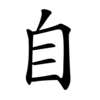自
| ||||||||
Translingual
| Stroke order | |||
|---|---|---|---|
| Stroke order | |||
|---|---|---|---|
 | |||
Han character
自 (radical 132, 自+0, 6 strokes, cangjie input 竹月山 (HBU), four-corner 26000, composition ⿱丿目)
- Kangxi radical #132, ⾃.
Derived characters
- Index:Chinese radical/自
- 息
References
- KangXi: page 1000, character 7
- Dai Kanwa Jiten: character 30095
- Dae Jaweon: page 1452, character 1
- Hanyu Da Zidian: volume 5, page 3046, character 1
- Unihan data for U+81EA
Chinese
| simp. and trad. |
自 | |
|---|---|---|
Glyph origin
| Historical forms of the character 自 | |||||
|---|---|---|---|---|---|
| Shang | Western Zhou | Warring States | Shuowen Jiezi (compiled in Han) | Liushutong (compiled in Ming) | |
| Oracle bone script | Bronze inscriptions | Chu Slip and silk script | Ancient script | Small seal script | Transcribed ancient scripts |
 |
 |
 |
 |
 |
 |
| Characters in the same phonetic series (自) (Zhengzhang, 2003) | |
|---|---|
| Old Chinese | |
| 郋 | *ɡiːl |
| 自 | *ɦljids |
| 洎 | *krids, *ɡrids |
| 臮 | *ɡrids |
| 垍 | *ɡrids |
| 詯 | *qʰʷlɯːls, *ɡʷlɯːls |
Originally a pictogram (象形) of a nose; in China (and East Asia) one points at one’s nose to indicate oneself, hence an ideogram (指事) of “self”.
The original meaning of “nose” has been lost. The derivative 鼻 refers to the original word.
Pronunciation
Definitions
自
Compounds
Derived terms from 自
|
|
|
Japanese
Readings
Korean
Hanja
自 • (ja)
- This term needs a translation to English. Please help out and add a translation, then remove the text
{{rfdef}}.
Vietnamese
This article is issued from
Wiktionary.
The text is licensed under Creative
Commons - Attribution - Sharealike.
Additional terms may apply for the media files.